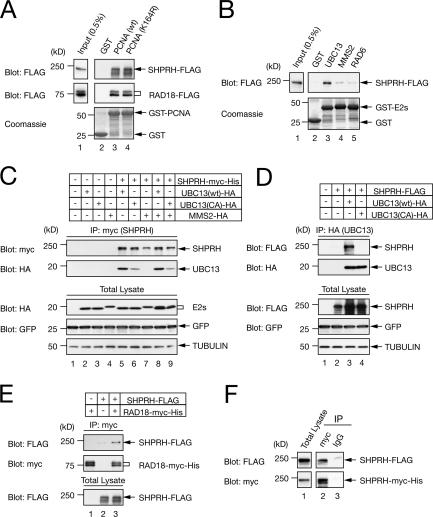Figure 3.
SHPRH physically interacts with PCNA, UBC13, and RAD18 and multimerizes. (A and B) SHPRH associates with PCNA and UBC13 in vitro. SHPRH-FLAG was pulled down with GST-fused PCNA (wild type or K164R mutant; A) or with GST-fused E2s (B) and analyzed by blotting with an anti-FLAG antibody. RAD18-FLAG was also pulled down with GST-PCNA (A). (C and D) SHPRH associates with UBC13 in vivo. SHPRH-myc-His (C) or SHPRH-FLAG (D) was coexpressed with wild-type UBC13-HA, UBC13(CA)-HA, or MMS2-HA in the combinations indicated. Anti-myc (C) or anti-HA (D) immunoprecipitates were blotted with an anti-HA (C) or anti-FLAG (D) antibody. Note that the level of SHPRH is enhanced in the presence of wild-type UBC13 and, to a lesser extent, UBC13(CA). SHPRH showed a weak but reproducible interaction with UBC13(CA). Blots with anti–α-tubulin or anti-GFP serve as loading or transfection control, respectively. (E and F) SHPRH interacts with RAD18 and self-multimerizes in vivo. In F, cell lysates expressing SHPRH-FLAG and SHPRH-myc-His were immunoprecipitated with anti-myc antibody and blotted with an anti-FLAG antibody. Normal IgG antibody was used for control.

